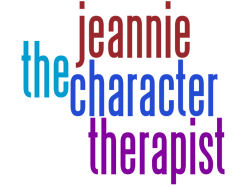|
Since
I’m new to CFOM, I thought I’d introduce myself by
sharing a bit about what I do for a living as well as enlighten you
about an important aspect of relationships and how to apply this to
your works in progress.
I’m a Licensed Marriage and
Family Therapist. My specialty is doing therapy with the entire family
to create change, produce healing, and strengthen ties. To do this, I
work with the family system. That is, the nuclear
family (mom, dad, children) and occasionally a grandparent or some
other significant family member who lives in the same house.
One of the pioneers of family
therapy is Murray Bowen. And just about everything I can share about
this man’s theories would shed a therapeutic light on your manuscripts,
but this month, I am writing about what Bowen considered the smallest
stable unit of relationship: the triangle.
According to Bowen, virtually
all significant relationships are shadowed by a third person.
Mom/Dad/Child. Husband/Wife/Mother-in-Law. Hero/Heroine/Heroine’s Other
Potential Boyfriend. When this happens, the third person is said to be
“triangulated” into the relationship, brought in to alleviate conflict.
Rarely (if ever) would a
therapist see two people in her office for couple's counseling when
some other third party wasn’t involved. If the couple doesn’t already
have
triangle, then they try to triangulate the therapist. Each has the
agenda to win the therapist over to seeing his or her side of the
story.
Are you nodding yet? You should
be—we all do this. When two people are unable to
resolve their problems, humans have an inherent bent to draw in another
person or group of persons (especially in a chick lit novel where the
heroine is part of a “pack,” then the other friends still serve as a
single unit for the purpose of this illustration).
There’s something stabilizing
about the triangle. We can have a riff with our spouses, call our
friends to gripe about how wronged we were, and then just feel
better. The healthier thing to do would be to go directly to
the other person and communicate our feelings and try to solve things
that way . . . but we typically don’t.
How true is this for almost all
relationships we have? Let’s take a second to consider a few
books/movies. You’ll see that they all center around one or more
triangles. Gone with the Wind:
Scarlett/Rhett/Ashley. Twilight:
Bella/Edward/Jacob. Pride and Prejudice:
Elizabeth/Darcy/Mr. Wickham.
Romantic triangles can also be
between two people, but three personas. Superman:
Clark Kent/Lois Lane/Superman. You’ve Got Mail: Joe
Fox/Kathleen Kelly/NY152 (Fox’s online persona). Down with
Love: Catcher Block/Barbara Novak/Zip Martin (Catcher’s alter
identity).
Triangles
don’t have to be romantic, either. Silence of the Lambs:
Clarisse Starling/Hannibal Lecter/Buffalo Bill. The Godfather:
Michael Corleone/Don Corleone/Kay. The Shawshank Redemption:
Andy Dufresne/Red/Warden Norten.
|
An
object, idea, or animal can
be triangulated, as well. Lord of the Rings:
Frodo/Sauron/The One Ring. Star Wars: Luke
Skywalker/Darth Vader/The Force. The Sandlot: Scott
Smalls/Benny Rodriguez/“The Beast” guard dog. Anna and the
King: Anna Leonowens/King Mongkut/Siam traditions.
I tried to think of a movie that
featured a solitary person, and the only one I came up with was Tom
Hanks
playing in Cast Away. But there was still
a triangle! Tom Hanks created Wilson, his soccer ball “friend,” to
alleviate his anxiety of being on the island alone, while cherishing
his pocket watch gift from Helen Hunt with her picture in it. So his
triangle was actually two objects, but one was representative of his
girlfriend.
A great movie that is a study in
triangles is Love Actually. It has several story
lines, but they are all interconnected by triangles. It also shows how
one person can have many triangles in his or her life—at work, at home,
at church—that can overlap at times.
So how can you apply this to
your manuscripts? Think about your book. Do you have a triangle already
in place? If you don’t, then you might want to think about going back
to the drawing board. No matter what genre you write, the triangle is
still relevant. Not only will it make the book more realistic, but also
triangles create the best tension and make readers yearn to know how it
will resolve.
The thing to remember is that
although triangles might stabilize a relationship, they also freeze
conflict in place. When a third person is brought in,
relational progress essentially stops. So ideally, the triangle should
be resolved by the time the character arrives at the end of their inner
journey. A good relational triangle can lend itself to a solid plot,
which should be music to the ears of character-driven novelists!
In therapy, the therapist’s goal
is to help the person work through the triangulation (their mother’s
well-meaning but awful advice, a friend’s jealousy, etc.) in order to
come to a mentally healthy place. In fiction, a writer’s goal should be
to produce a quality piece of work that others want to keep reading
because they relate to it on some level. Our work touches something in
them.
Thinking about relationships in
your novels in the context of triangles will help your writing achieve
a psychological level of authenticity that engages the reader and keeps
them flipping pages well past bedtime.

|